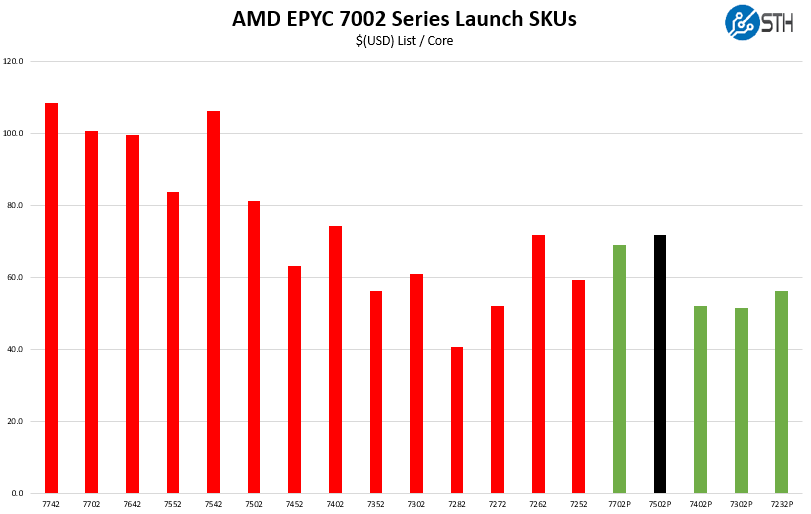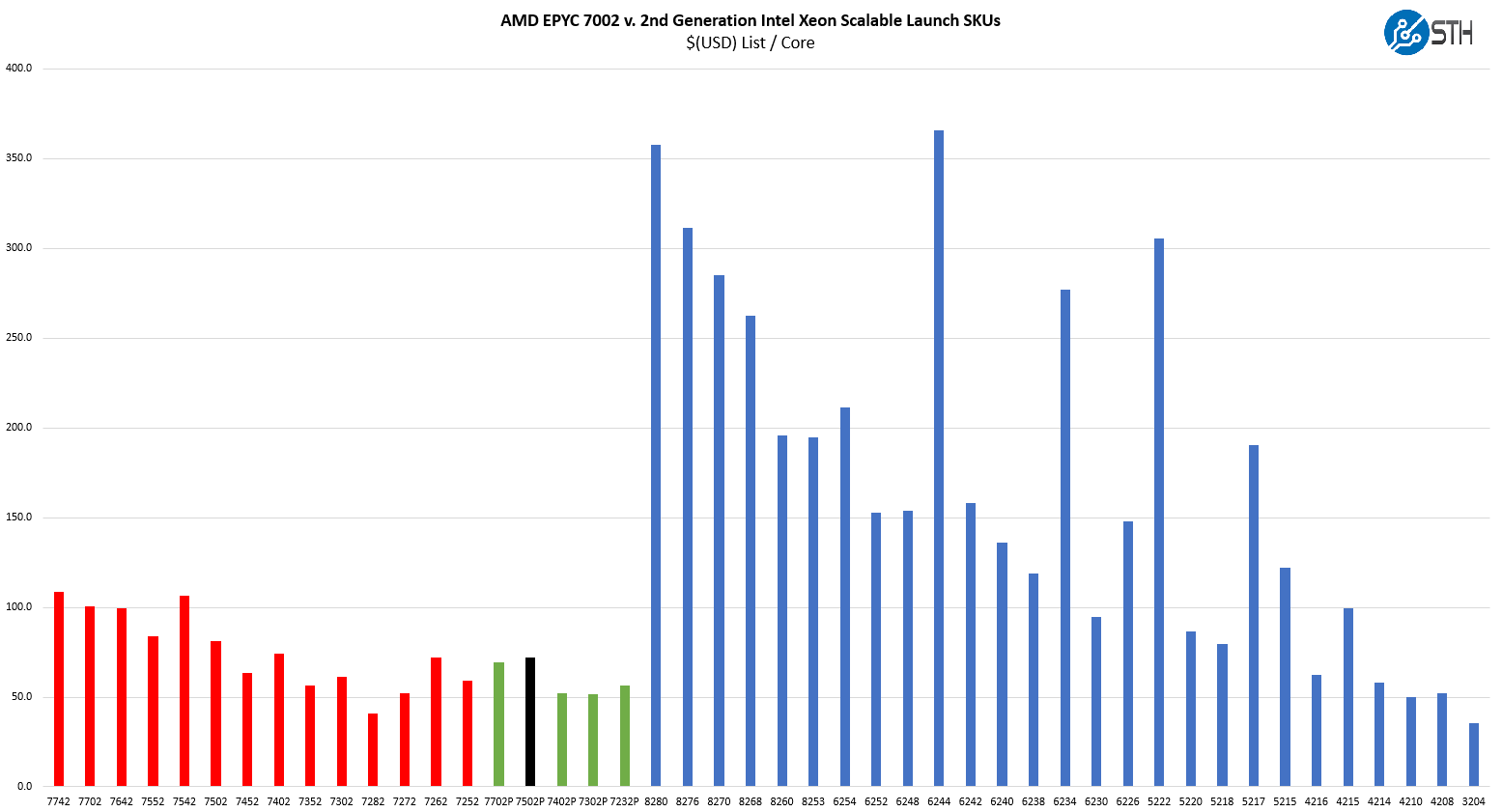AMD EPYC 7502P Market Positioning
Thes chips are not released in a vacuum instead, they have competition on both the Intel and AMD sides. When you purchase a server and select a CPU, it is important to see the value of a platform versus its competitors.
AMD EPYC 7502P v. AMD Alternatives
The AMD EPYC 7502P has competition within the AMD stack itself. It turns out that the AMD EPYC 7502P is the highest cost per core CPU in AMD’s “P” range of single-socket products. Here is a chart from our Intel Xeon W-2200 Series Launch SKUs and Value Analysis piece:

Indeed, the EPYC about the same cost per core as the AMD EPYC 7262, and the AMD EPYC 7402 (non-P). The former may not be exciting as an 8 core and 32 core CPU may not be overly competitive. When looking at the AMD EPYC 7402 one can more or less scale down to 24 cores at a significant cost per core discount using the EPYC 7402P. One can maintain the cost per core and scale up to 48 cores using two EPYC 7402 (non-P) parts adding more memory capacity and bandwidth per core.
At 64-cores the AMD EPYC 7702P is actually less expensive on a per-core basis than the EPYC 7502P which is not the case on the dual-socket capable parts.
The pricing is a bit strange in relation to its peers, but if you want more than 24 cores and less than 64 cores in a P-series part, the AMD EPYC 7502P is the best CPU value.
Moving beyond the cost per core, and thinking at a system level, we see the EPYC 7502P make a lot of sense. While enterprise VM hosts tend to use more RAM, in the cloud, 8GB of RAM per core is fairly common. With 8x DDR4 channels, and 32GB DIMMs, that fits perfectly with a 32 core CPU. You can move to 16x 32GB or 8x 64GB and hit 16GB/ core. If you are in an organization with many RAM hungry VMs and low CPU load, then the EPYC 7502P can handle up to 16x 256GB DIMMs for a 4TB configuration. Frankly, it is often less expensive in the 128GB and 256GB per DIMM configuration to move to dual sockets just to lower your price per DIMM.
AMD EPYC 7502P v. Intel Xeon Alternatives
Taking a step back, the big player in the market, from a market share perspective, is still Intel Xeon. The 32-core AMD EPYC 7502P outpaces the Intel Xeon W-3275 28-core single socket only part in most of our tests and has more memory capacity and PCIe capacity as well. While the EPYC 7502P looked like a top half of EPYC list price CPU, when we instead turn to the 2nd Gen Intel Xeon Scalable line, things are different:

Even though this is a 32-core CPU, it has list pricing around that of an Intel Xeon Gold 5218 on a per-core basis which is the lower-mid-range of Intel’s stack. Performance-wise, it is most competitive with the Intel Xeon Platinum 8280 (leftmost blue bar) or the Intel Xeon W-3275 mentioned earlier. The value here is unmistakable.
Beyond the performance and core counts, AMD also has PCIe Gen4 with 128x lanes supported. Intel has 48x PCIe Gen3 lanes per mainstream Xeon and 64x lanes on the W-3275. If you are building a storage platform, e.g. for a Gigabyte R272-Z32 24x NVMe system or similar, then the platform value proposition is undeniable.
Intel has a handful of advantages beyond sales momentum owing to a long history. The company has Optane DCPMM available on most of its Xeon SKUs. It also has newer instruction extensions such as AVX-512 and DL Boost (VNNI.) If you must have those features, then Intel is the way to go. Intel also has more platforms in the market. With the AMD EPYC 7002 Series, AMD and its partners have been doing a better job increasing platform diversity. Still, there are places in the market where there is no current AMD solution publicly available. An example of this is an NVIDIA SXM2 GPU solution such as a Gigabyte G481-S80. For general-purpose systems, there are plenty of systems, including those for PCIe GPUs and accelerators. In some segments, the only choice is still Intel.
Final Words
With 32 cores and attractive pricing, the EPYC 7502P shows why it is set to become a favored option. Intel does not have an answer for the EPYC 7502P that is not 2x-4x the price. To think, this is a fairly mid-range chip for AMD. As a result, its strongest competition likely comes from moving up or down in the EPYC stack.
The “P” series single-socket part with a 32 core chip is going to be interesting to many of our readers. If you were shopping in the Intel Xeon Gold 5218 range, you can consolidate from two sockets to one resulting in fewer NUMA nodes and lower power consumption. That is all while getting more performance and expandability than the Xeon Gold solution. We see the opportunity to easily size a system to 8GB or 16GB of RAM per core while still using commodity 32GB DIMMs as an additional cost-benefit of the systems.
All told, we think a lot of organizations will find the AMD EPYC 7502P to be the right balance of performance, power, expandability, and cost for their deployments. AMD did a great job offering a CPU that can push organizations to single-socket platforms which can dramatically lower price and power consumption.




That’s a cool cover photo. We’re going to look to quote these out v. Intel Xeon but even with the discounts we’re being positioned the 8260’s as competitive. Based on this, we’ll ask for an update
What motherboard gives pci 4 instead of pci 3 like the Supermicro I mostly use?
we went with the 7502 for a new vsphere cluster. superserver 1114s includes pci4 so we can test new mellanox 100g cards.
Hey dpf, where did you purchase you 1114’s from? We have one on order and it’s taking forever for it to get in.